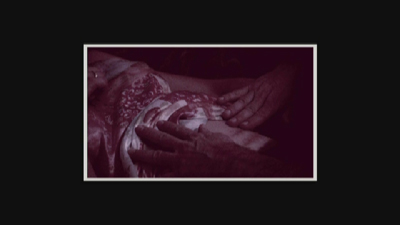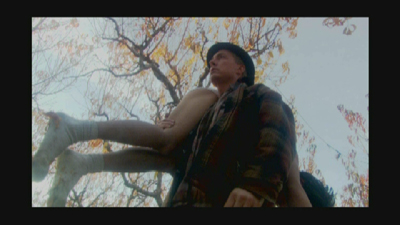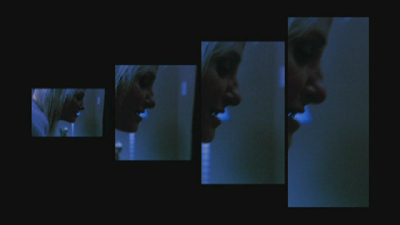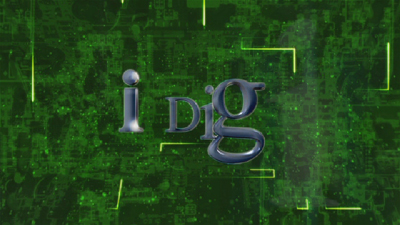 BUY IT AT AMAZON: CLICK HERE!
BUY IT AT AMAZON: CLICK HERE!
STUDIO: Heretic
MSRP: $19.95
RATED: NR
RUNNING TIME: 100 Minutes
SPECIAL FEATURES:
• "Movies Not Excuses" featurette
• "Misa Does Make-Up" featurette
• Feature commentary
• Soundtrack CD
• Trailers
Reactionary
filmmaking is an interesting beast. A filmmaker sees a trend in culture (broad
or specific) and decides to make something that rebuts the reasons for that
trend. According to KatieBird‘s creator, Justin Paul Ritter, his film was created
in reaction to the exploitative themes running through mainstream
rewrites on crappy films, got fed up with the process, and pounded out the
screenplay for KatieBird in just a couple of days. It’s a different sort of
reactionary piece, exulting in the subjects it is allegedly attacking, and the
result is a film that is as conflicted in nature as its psychotic subject.
The Flick
KatieBird
is the (apparently real) name of our protagonist. She’s not a hero by any
stretch of the imagination; she’s just the point around which the story
revolves. We first see her returning from her father’s funeral in the company
of her personal doctor. KatieBird’s father was not well-loved, having been a
notorious serial killer, so the doctor tries to offer a measure of comfort and
healing for poor KatieBird.
In
return, she bashes him over the head with a vase, chains him to a bed and
tortures him. Her tools of choice are mainly of the hardware store variety, but
she also forces him to endure her life story. This framework surrounds a mess
of flashbacks, which are the meat of the film, detailing KatieBird’s life as an
only child with her single father and their blood-soaked barn of surgical
appliances.

"I call this one Snapshots of a Botched Abortion."
There’s
the potential in the story for a good deal of violence and tension, but Ritter
has downplayed those elements in favor of exploring the psyche of his
protagonist. KatieBird isn’t so much a horror film as it is a thriller, a
more graphic Kiss the Girls. I’m comparing Ritter’s movie to a generic
both have about the same level of insight into the psychological conditions of
their featured murderers.
KatieBird pretends to be an origin story of
a serial killer, but it completely misses that mark. Origin stories are
fascinating because of the causality, the linking of situations that brings a
context to the sometimes inexplicable actions of strange characters. People
want to know how Hannibal Lecter got to be the way he is, or, for that matter,
Ed Gein. Turns out, though, that the explanation for KatieBird’s psychoses is
no more complicated than that of, say, Leatherface. In other words, her home
life was diseased, so her mind got a little broken.
Too much
of the script is devoted to surface evaluations of KatieBird’s motivations, but
they never get any deeper than the story problems on a Psych 101 exam. It’s a
shame, not only because it fails to deliver on its own promise, but also
because Helen Udy (My Bloody Valentine), who plays KatieBird, is so very good at
portraying a fractured mind. She oscillates wildly between sympathetic, batshit
insane, and points in between.

"We’ve secretly exchanged this young man’s underwear for
three-inch nightcrawlers. Let’s watch!"
In part
as an attempt to mirror KatieBird’s state of mind, Ritter deploys an editing
technique similar to the comic-frame elements of Ang Lee’s Hulk. Bits of the screen
are divided and subdivided, manipulated in shape and shifted around to create a
collage-effect. Rather than being a stylistic emphasis, though, they are
present in nearly every shot. In fact, it’s rare to have a shot that fills the
frame from edge to edge. Think Time Code, but with much more
variety.
There’s a
problem with this technique as it is applied to KatieBird. That kind of
blatant post-production hand never ceases to remind the audience that they are
watching a movie on a screen while sitting in a comfortable chair. It makes the
fourth wall impenetrable, and translucent rather than transparent. Erecting
such an obstacle works just great in movies that delight in their estrangement
from reality, but here, when the filmmakers are trying to create a gritty
reality, it’s a poor match. It is used effectively in a number of sequences,
but those are far outweighed by those sequences in which it appears gimmicky.
For those
who can stick by the alternative methods, there is a reward in blood. The gore
effects are minimal, but well-executed. The tension during sequences of torture
is a bit hit-or-miss, but when it’s on it’s most definitely on. My favorite
cringe-inducing scene is a multiple tooth extraction that is more excruciating
than the famous claw hammer job in Oldboy.
The
premise of showing the birth of a serial killer is an interesting one, but KatieBird
never follows up on it. We get to see situations, but they’re divorced
from any meaning thanks to their predictable and repetitive nature. The
audience is distanced further from any real involvement in the film by the
dialogue which seems to assume that there is, in fact, great importance to the
events in KatieBird’s past. Ritter fell victim to the old "show, don’t
tell" maxim. KatieBird tells us all sorts of things about how these
vignettes of her past shaped her impressionable mind; but, if her commentary
were removed, we’d be really hunting for an explanation.
Justin
Paul Ritter has an expansive imagination and an apparent talent, but KatieBird
is a hive of broken promises, an exploitation film too concerned with its own
voice to tell us much of anything coherent.
6.1 out of 10

"Piggie passed out. I’m-a go hunting for truffles."
The Look
It’s in
16×9 widescreen, but you won’t hardly notice thanks to the experimental editing
and framing. Because individual shots are expanded and contracted so much to
serve the style, I was on the lookout for compression artifacts, but saw none.
The transfer has been well-optimized , and serves the variety of tones (warm
autumn, cold night, antiseptic fluorescence) beautifully.
8 out of 10
The Noise
The
soundtrack is only in Dolby 2.0, but the filmmakers have done well with the
limited canvas. Everything is mixed to right where it should be. On smaller,
cheaper pictures, there is often a tug-of-war between the score and the
dialogue, but that isn’t the case with KatieBird.
Speaking
of the score, it’s pretty awesome. Composed by Daniel Iannantuono, it’s almost
entirely a guitar-bass-drums combo that ought to put the viewer in mind of apocalyptic
rock bands such as Explosions in the Sky or Godspeed! You Black Emperor
(wherever you want to put the exclamation point). The set even comes with a
soundtrack CD, which I’ve been listening to in other contexts. The stuff is not
bad, and serves the movie well.
7 out of 10

No matter where you’re torturing helpless doctors,
Cingular has more bars for you.
The Goodies
The
bonuses kick off with a fourteen minute featurette called "Movies Not
Excuses," which consists entirely of director Justin Paul Ritter directly
addressing the camera. He would like the camera to know that it should stop
making excuses about not getting around to its art — be it filmmaking or
writing or whatever — and get some damn work done. It’s a good encouragement,
but Ritter’s limited experience and undeveloped rhetoric skills give the
feature an air of condescension.
Following
that is a bonus on the makeup called "Misa Does Make-Up." For about a
minute, we see behind-the-scenes info on make-up artist Misa Aikawa and her
methods. It’s too brief a feature to get into much detail or interest.
The disc
also carries a commentary track featuring Justin Paul Ritter, Helen Udy, and
her co-stars Taylor M. Dooley and Lee Perkins. The actors have a nice
interplay, but it really is Ritter’s show. His brand of amateur philosophizing
may not get on your nerves as much as mine, but there’s no denying that, at the
end of the day, this is an auteur film. It’s just peppered with his finger
prints. In my opinion, he tries too hard to sell the film through his own
interpretive lens. He has made the film, now, and so he needs to step back and
let the audience interact with it on their own. However, a commentary track is
exactly the right place for a director to go hog wild with his opinions, so, in
that regard, this is a great track.
There are
also two sets of trailers: KatieBird teaser and theatrical
trailers, and trailers for other releases from Heretic.
6.8 out of 10

A new line of hip archaeological tools coming this summer from Apple!
The Artwork
The cover
art is set up like an introduction to the film’s visual style with three
different frames of varying sizes showing KatieBird in the three different
stages of her life: youth, young womanhood, and Udy. It’s decent, but not
striking enough to leap off the shelf at anyone.
6.5 out of 10
Overall: 6.3 out of 10